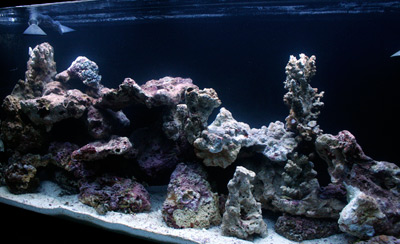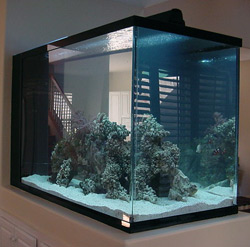Your long-anticipated live rock shipment has finally arrived at your doorstep, and you can’t wait to get it in your tank and start watching as life emerges from those gnarly chunks. Though you’re understandably eager to forge ahead putting the rocks in place, it’s critical at this stage to give more than passing thought to how you should arrange them. Inappropriate aquascaping now can lead to major headaches—or at least less-than-satisfactory results—down the road.
Here are five live rock aquascaping pitfalls you should take pains to avoid:
1. Placing your rock structure atop the “shifting sands”
If your system will include a substrate of any significant depth, the first layer of rocks should be placed either right on the tank bottom (or a thin cushioning layer of substrate) or atop some type of secure supportive structure (e.g., pilings constructed of PVC pipe, a framework of egg crate material, etc.). If placed directly on top of a deeper substrate, the rockwork can be easily undermined by burrowing/digging/tail-fanning fish or inverts, potentially resulting in a catastrophic rockslide.
2. Building a wall of rocks directly against the glass
If at all practicable, try to avoid building a rockwork stack right against the back glass or other panes. Doing so creates undesirable circulation “dead zones” (where copious amounts of detritus can accumulate) and will prevent access to those areas for cleaning/maintenance.
Allowing open space all around your rockwork also gives your fish much more freedom to swim in a natural pattern instead of having to stop at either end of the tank and turn around repeatedly.
3. Rendering equipment inaccessible
We marine aquarium hobbyists generally prefer our tanks to look as naturalistic as possible and, so, make every effort to hide powerheads, heaters, and other submerged gear from view. This is often achieved through strategic placement of live rock. However, you do have to be careful to avoid obscuring any device in such a manner that it’s necessary to tear apart the rockwork structure whenever you need to access it for cleaning or maintenance (which, by the way, will become more and more problematic as corals spread over the rockwork).
An example of this pitfall is hiding a submersible heater behind the aforementioned rockwork stack that’s situated up against the back pane, making it impossible to reach for temperature adjustments, cleaning, or replacement if needed.
4. Burying the good stuff
Make no mistake, quality live rock is expensive. The last thing you want to do is sacrifice several costly pieces to the bottom layer of aquascaping in a tank with a deep substrate. If you aren’t placing some sort of supportive framework/pilings under the rocks so they’re all positioned above the substrate (and thus need to place the first layer right on the bottom of the tank), use inexpensive base rock for your foundational layer instead of live rock. Otherwise, all the encrusting organisms you paid the long dollar for will simply be smothered in the sand.
5. Failing to account for coral placement and growth
If you’re creating a reef system, keep in mind that your coral specimens will need suitable niches/ledges in the aquascaping to allow for stable placement and full expansion. A monolithic wall of rocks is very poorly suited to this purpose. As you aquascape, try to envision where you’ll be placing corals (even if you don’t know exactly what they’ll be yet) for a composition that’s not only pleasing to the eye but allows adequate spacing between specimens. Then try to arrange the rocks in such a manner that there’s a good coral-placement niche in each of those locations.
Also, don’t forget that corals grow—a lot! You have to account for that potential growth when aquascaping, for example by avoiding stacking the rocks too close to the surface or the front viewing pane.




